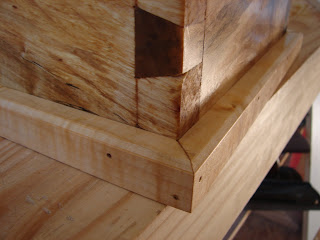Waterstones are messy. My old process was to pull the stone out of its bath, set it on a rubber mat and keep lots of towels handy to catch any runoff or build up of the slop. It really made sharpening a chore. I even looked at other systems, i.e., oil stones (Norton's tri-stone thingy that revolves), diamond stones and diamond paste. Not wanting to waste my investment, I researched as much as I could to find out the most sensible way of holding and containing waterstones.
David Finck, author of Making and Mastering Wood Planes, shows a set up in his book. Basically, a cradle is made to hold the stone over a pan or container. The cradle is dadoed on either end to fit the lip of the pan or container.
So I set off design something for myself, with David's setup as my model. The most obvious thing to me was that the less the stone had to travel from bath to cradle, the better. My setup had to definitely place the stone over the bath, thereby allowing the slop to run off the sides and into the container.
It had to be pleasing to my eyes. Simply setting the stone on a block over a piece of Tupperware did not sit well with me. But not wanting to go through the process of epoxy-coating the interior of a wooden box, so that it may hold water, I decided to build a box to hold the container.
I'm still a very novice woodworker. This would give me a chance to practice some basic skills. A through-dovetailed box was the project.
I wrestled with how to set in the bottom. I couldn't pass up the ease of just nailing it to the bottom edge. It will probably self destruct in the future, but, oh well; it looks and works nicely now.
The box begged to receive moulding along the bottom. Having no moulding planes at the moment, I just chamfered the edge. Box complete.
The cradle had to be of a rot-resistant wood. I had some redwood on hand, and just enough of it actually. The stock I had was only 5/8" thick, so I laminated two boards together, and the finished block is about 1 1/4" thick. After laying out the dadoes on either end, I sawed the lines and the waste, and cleaned it out with a chisel. The stops on the block were planed down to 3/8" in thickness, and glued to the face of the block. One stop had to have a slight angle cut on it to receive the wedge which holds the stone tight.

Two coats of boiled linseed oil —to bring out the color— and three coats of wipe-on poly followed up with a coat of wax finished it up. It hasn't been used yet; I expect it to get really dirty and wanted to take some pictures of it before it got to that point. The stone in the picture is a dry coarse stone; my honing stones are in the tub outside of the frame. The tub fits in tightly, too tightly. When I started this project I had planned on making a pond-liner covered box to insert. I'll still probably do that but this will work for the time being.
I had never planned on this project getting this far. That's why I don't have any pictures of it in process. The soft maple used for the box was just scrap stuff I had laying around, and after finishing it I couldn't believe how much I loved the look of that maple. Some spalting, tiger stripes and other things going on.
I'll be sure to post a couple of pics of it in use. This little station should help make my sharpening life easier.
AMDG









